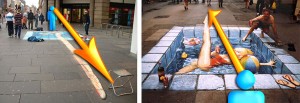Imagine you are walking the down the street, and up ahead you see a big hole in the pavement. But when reach the hole that you saw a while back, it is nothing more than chalk on the ground. This type of 3D illusion has gained immense popularity around the world. For example, Julian Beever, has been traveling the world shocking his audience with extreme three dimensional illusions.
Julian uses a technique called “anamorphosis” which is drawing in a distorted and stretched out way. He almost always completes his work by using his eye, instead of computer or calculation programs. By setting up a camera from the viewpoint in which the work is meant to be displayed, Julian can determine where he needs to draw certain aspects of the piece in order to make it seem three dimensional. This artwork requires a certain type of smooth pavement. Julian uses dry pastel chalks and pigment. His pieces can take up to four days to complete so Julian relies on good weather to finish his masterpieces.
According to our book, perceptual experience is taking information from our environment and converting this information into action potentials in order to build a representation that environment. Using action potentials, the chalk drawings done by Julian Beever, are often misinterpreted as actual three dimensional objects or scenes.
Errors of perception or the phenomena of illusions, are due to misapplied available knowledge. Since we, as humans, rely on vision as our primary sense, objects that are often fragmented are perceived as whole due to accumulated knowledge in order to make sense of the sensory signals that are sent to our brains. Since retinal images are inherently ambiguous, such as shape and size, knowledge is necessary to recognize these objects. These ambiguities are resolved from what is known of the object world. Therefore we can say that perceptions are just hypotheses which predict characteristics of objects.
References:
- “Homepage1.” Homepage1. N.p., n.d. Web. 02 Feb. 2014. www. Julianbeever.net
- “Welcome.” Professor Richard Gregory On-line. N.p., n.d. Web. 02 Feb. 2014. http://www.richardgregory.org/papers/knowl_illusion/knowledge-in-perception.pdf
3. Goldstein, E. B. (2011). Cognitive Psychology: Connecting Mind, Research, and Everyday Experience. Belmont, CA: Wadsworth.

Experiencing Illusions
The experience you describe in ‘Illusions’ of suddenly coming upon a big hole in the pavement happened to me just this past week. It was a rare day of heavy rain in Los Angeles and the result had been pretty decent flooding just about everywhere. It was fairly late in the evening and my son and I had decided to grab a quick dinner from a nearby fast food restaurant. As I pulled the car around to the drive-through lane, there it was – a giant black hole in the pavement! I slammed on the brakes, completely unable to believe what I was seeing – an enormous section of the parking lot and drive-through gone, apparently collapsed down onto the freeway ramp below. I continued to stare for a good 7 to 10 seconds until my brain figured out what was really happening. The pooled rainwater combined with the way it was lit by the parking lot lights had created an amazing illusion to me. However that illusion was only my perception, how my mind created a representation of the world, how my top-down and bottom-up processing were working. To my son, who saw the exact same pool of water, sitting in the same car had an entirely different perceptual experience. To him, it was only rainwater.